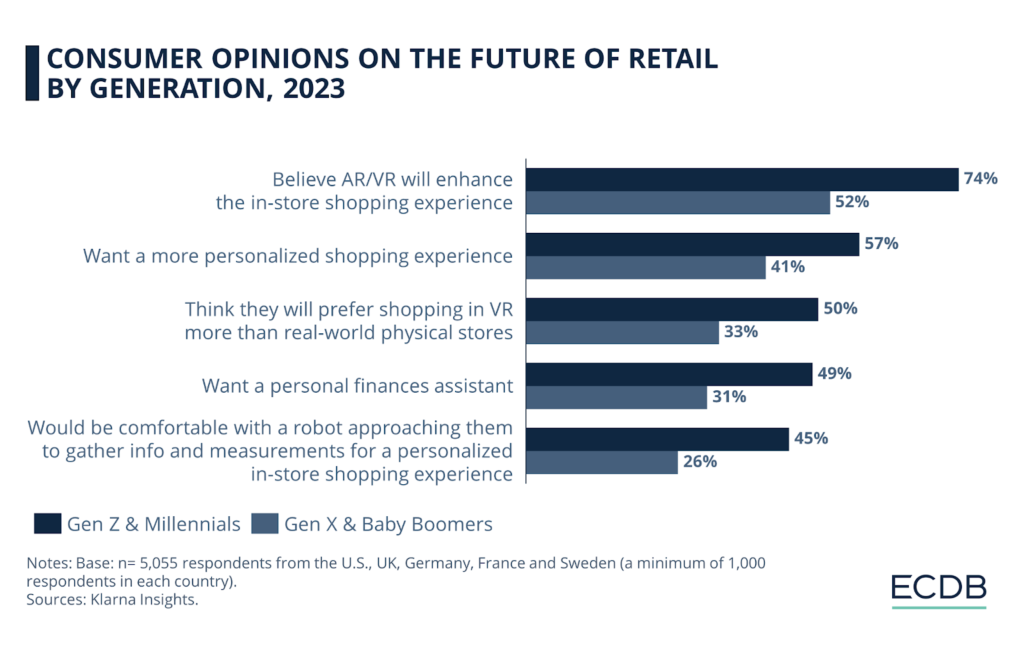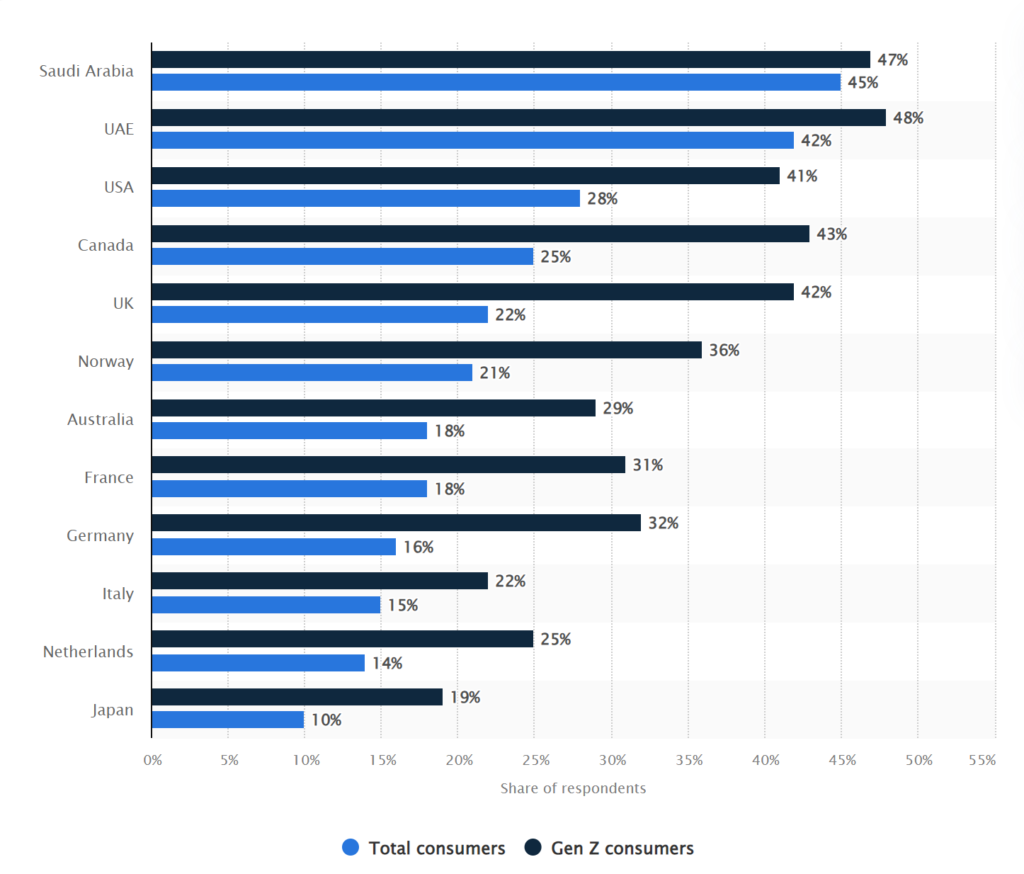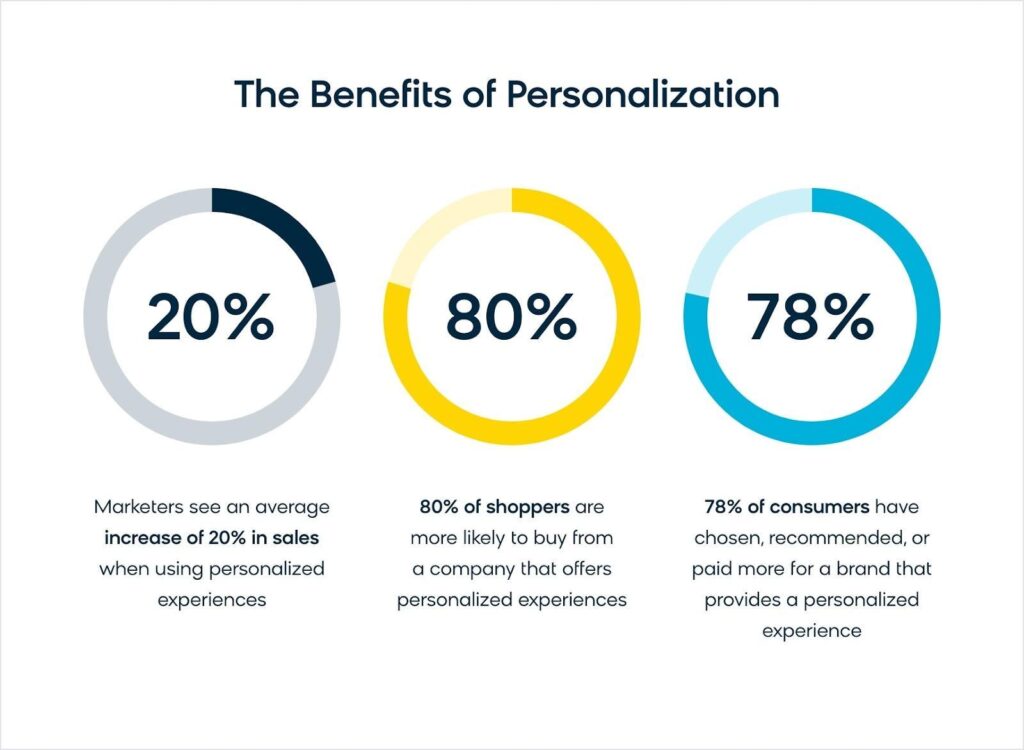Having and retaining a competitive edge in today’s eCommerce market is more difficult every day. That’s why it’s absolutely vital to know everything you can about delighting your customers and boosting your bottom line in the process.
Immersive retail is your key to achieving both of these goals, and more.
We’re going to take you through the ins and outs of immersive retail, from a definition of the term to a breakdown of what makes it so essential in the world of eCommerce.
We’ll start with the definition and work our way up from there, ending on a list of best practices.
Ready?
Let’s jump right in.
Bonus Content: We Analyzed 1000s of Online Stores, and Here Are the Top 29+ Marketing Mistakes You’re Making!
What Does “Immersive Retail” Mean?
Broadly speaking, retail happens across two avenues: eCommerce retail stores, and more traditional brick-and-mortar stores. Right?
Well, not quite.
As any experienced eCommerce businessperson knows, there’s a whole lot of wiggle room between physical and virtual stores.
And we’re not even talking about temporary setups, like pop-up stores, either; instead, we’re talking about doing business in virtual reality.
Immersive retail doesn’t necessarily have to use VR technology, but it very often does.
That’s because immersive retail is all about adding new dimensions to stores, so customers can fully experience using and even owning your products before they’ve made a purchase.
It’s also plainly visible that the immersive approach has become much more popular recently; by and large, customers see it as an integral part of the future of retail and eCommerce.
As you can see below, this is particularly true for the younger generations, as 74% of millennials and Gen Z believe that AR/VR will enhance the in-store shopping experience.
[Source: ECDB]
Real-world examples of immersive retail include virtual try-on experiences and gamified shopping experiences, both of which take a new approach to tried-and-true retail tactics.
What Makes Immersive Retail So Important?
The following benefits for retailers come with providing immersive retail experiences — and they show exactly what makes immersive retail so worthwhile.
1. Better Customer Engagement
Enhancing customer engagement is a key business goal for many companies, especially those that don’t offer an in-store experience. That’s because it can be much harder to drive engagement when sales professionals can’t speak face-to-face with customers, or guide them as they would in person.
Immersive retail is a sure path to improved virtual customer engagement. Effective eCommerce marketing strategies (including influencer marketing) leverage immersive technologies to create personalized and engaging online shopping experiences.
The more immersive an experience is, the more likely customers will be to engage with it.
Either they’ll be curious about this brand-new experience, or they’ll be excited to approach products they’re interested in via an immersive shopping experience. It’s a win-win, both for them and for you.
2. Greater Customer Loyalty
Great retail experiences make customers happy, as we’ve established — but there’s more to it than that.
If you can create immersive experiences that linger strongly in customers’ minds, they’ll start to associate your brand with their excellent customer experiences.
That means they’ll be more likely to come back the next time you offer more interactive experiences, because they already know you’re good at them and can be trusted to give them an amazing experience.
In other words, it’s very much worth it to provide that immersive shopping experience if it helps you keep your customers coming back (and spread the word about your brand), especially as just a 5% increase in customer retention rates can lead to a significant increase in profits.
[Source: FinancesOnline]
3. Better Differentiation
One of the hardest things about operating as an eCommerce business at the moment is the sheer volume of competition. From fashion retailers to eCommerce giants like Amazon, there’s certainly no shortage of online retailers in just about any sector.
Immersive retailers can stand out from that crowd.
When you offer experiences outside of the norm and beyond what’s expected, you’ll really be able to distinguish yourself as a unique brand. This helps you attract more customers and maintain interest in your brand, making it one of the main benefits to retailers going into immersive shopping.
For example, H&M’s recent release of their Metaverse does just that. It takes virtual shopping and dressing rooms to the next level, as H&M uses augmented reality to allow customers to try on and create digital looks using the H&M app, creating a memorable, fun, and more sustainable fashion experience.
[Source: H&M]
Don’t have H&M’s budget? No problem.
You can start as small as the way you write quotes or invoices, or how you create your transactional emails.
By clearly communicating your brand’s values and vision in even the mundane, you reinforce your brand identity within immersive retail experiences. This transparency and attention to detail can enhance customer trust and satisfaction, ultimately contributing to stronger brand loyalty.
Immersive Retail Best Practices
Now we’ll be sharing some advice with you to help you start off on the right foot. Immersive retail can be complicated — so we’re breaking it down into simple tips below.
1. Don’t Be Afraid to Use New Tech
Technology is the backbone of a healthy society. When it comes to eCommerce, that certainly includes retail technologies, and, more specifically, immersive technology.
The digital technology market is always expanding as well. That means that something that’s cutting-edge one month could be replaced in the next, and even become obsolete within a year.
So, if you’re hoping to make the most of immersive retail, be sure to keep on top of new tech, and to try it out. You never know which new piece of mobile technology will let you offer an immersive shopping experience to phone users!
Below is the forecast share of consumers who will have used AR when buying products online worldwide by 2025, by country:
[Source: Statista]
A good way to stay on top of technology is by investing in enterprise SaaS options instead of basic tool plans.
Tip: What is enterprise SaaS? Enterprise SaaS is usually a more high-end, customized plan that a software service or app offers clients. For instance, at StoreYa, we have three tiers for our Traffic Booster that merchants can choose from, and then our creme-de-le-creme enterprise option here.
2. Keep the Focus on Your Products
It can be so tempting to get carried away with the whole “immersive” idea and start offering VR experiences just for the thrill of it. But remember: The point of these experiences is always to sell a product.
Offering 3D product previews, for example, is always going to be helpful. A 3D product visualization is even better, as it lets customers see how they would look or feel when interacting with your products.
A really fun, interactive game that barely bothers with product displays, on the other hand, is not going to help you make sales.
Whether you’re selling physical or digital products, be sure to keep the focus on those. Remember: Realistic product previews are more valuable to your customers than over-gamified experiences that leave them wondering what you’re actually selling.
3. Personalize as Much as Possible
From fashion brands to heritage brands and well beyond, retailers know they need to appeal to customers as individuals, not a faceless group.
This is because it helps customers feel seen and valued, which encourages loyalty.
You can boost your brand’s eCommerce personalization through well-crafted immersive experiences.
That’s because immersive retail is full of content for personalization, including tailored suggestions and pre-assembled lists of activities or interactions for your customers to try.
[Source: Bloomreach]
4. Design Holistic Experiences
If you were to create your perfect living space, you would probably want to customize every inch of it. The furniture, the walls, the art — everything would have to reflect you as a person.
Your immersive retail space is the same, only you’re customizing it for your audience.
In other words, focus on designing the entire space they’ll be occupying virtually. The colors they see, the actions they can perform, and everything else should combine to give them a full, immersive experience that’s more than just a digital space.
Bonus Content: How to Build a Winning Multichannel Marketing Strategy
5. Keep a Close Eye on Trends
Few industries are quite as fast-paced as eCommerce retail. This is at least partially because eCommerce trends often come and go very quickly, meaning it’s absolutely vital for successful brands to keep their finger on the pulse of their audience at all times.
The same holds true when you’re putting together an immersive retail plan.
From seeing what’s popular in TikTok eCommerce to following trending topics on sites like X (formerly Twitter) or Instagram, you’ll have an easier time creating amazing immersive experiences if you know what your audience wants.
6. Use Augmented Reality
Augmented reality (AR) is a type of technology that lets you blend virtual reality with the real world around you. This is why it’s sometimes also called extended reality.
By using AR, you can let customers experience a kind of mixed reality, in which they both interact with the world around them (real) and your products (augmented). This helps them envision a reality in which they already own the things you sell.
AR can also let customers try products from the comfort of their own homes. That way, you can replicate the immersion of in-store shopping while still operating as an eCommerce brand.
[Source: eMarketer]
7. Make Things More Interactive
As with AR, your content should be as interactive as possible if you want to give customers the feeling of being fully immersed.
For example, that might mean letting them perform an action to change the color of an item they’re considering, so they feel involved in the process of choosing and trying out a product.
Immersive content should also be interactive beyond the point of picking out products. Customers can get that experience at the supermarket. You want to provide them with something exciting and unforgettable, something they can get nowhere else.
In this regard, it can help to get dedicated and experienced content creators involved. They can give you a hand in designing fully interactive experiences.
8. Rely on Gamification
In 2023, nearly half of the retail decision-makers in a survey indicated that they had invested in providing customers with gamified shopping experiences.
This sends a clear message that making retail environments more “fun” for customers through gamification is a great idea. And gamification is ideal for an immersive retail environment.
In other words, the digital environment you create for your immersive experiences should be full of fun activities that customers actively want to do. Everything should feel like a game, never like a chore.
Final Thoughts
Immersive retail gives you a fantastic opportunity to wow your customers.
It’s a type of retailing that’s highly unlikely to go out of style anytime soon, because it’s very versatile, and, frankly, fun. Your customers get to enjoy the shopping experience more, while you get to enjoy increased revenue and customer engagement.
Plus, 3D AR experiences with your products help customers make conscious, informed decisions about what to buy. That means fewer returns and refunds, and more happy, loyal customers.
In a word, immersive retail is incredible. It’s full of potential that you can tap into in plenty of different ways — so give it a try yourself and experience its transformative power.

Nick Brown is the founder & CEO of Accelerate Agency, the SaaS SEO agency. Nick has launched several successful online businesses, writes for Forbes, published a book and has grown accelerate from a UK-based agency to a company that now operates across US, APAC and EMEA.
Recommended articles
 Facebook Ads for eCommerce: 16 Strategies, Examples & Tips
Facebook Ads for eCommerce: 16 Strategies, Examples & Tips
 How to Build a Winning eCommerce Ads Strategy
How to Build a Winning eCommerce Ads Strategy
 Google Ads for eCommerce: Everything You Need to Know
Google Ads for eCommerce: Everything You Need to Know
 10X Your Traffic with PPC Management Software
10X Your Traffic with PPC Management Software
Comments
Powered by Facebook Comments








